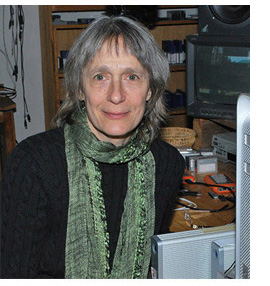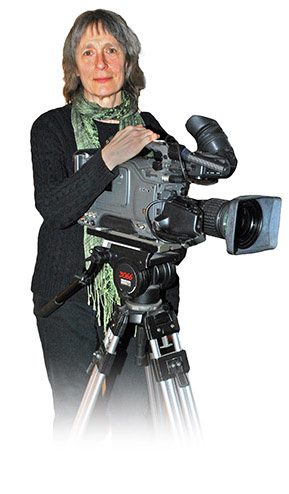| Vermont Filmmakers’ Quest for a People’s History | |||||
| by Amy Lilly | |||||
|
|||||
In 2005, Norwich filmmaker Nora Jacobson had an idea for a film about Vermont. Her father, a New York playwright, had moved to the state as a young man in 1936 and bought a farm. Nicholas Jacobson was one of many urban artists to populate Vermont over the last century. Jacobson was interested in examining Vermont’s “interesting mix” of “people who have moved here intentionally and integrated themselves,” like her father, “and people who have lived here all their lives with no choice in it,” recalls the 61-year-old. But soon Jacobson began to think, “One person shouldn’t tell the story of a state.” The filmmaker sat down with a friend, Burlington Free Press film reviewer Susan Green, and the two drew up a list of “everything we could think of that contributed to the way we see the state today.” Jacobson suggested some of these topics to filmmakers she thought might be interested in them. Other directors, hearing of the project, proposed segments exploring their own interests. The list grew. Over the next nine years, Jacobson cut and stitched together countless reams of footage from her own camera and those of 47—yes, 47—other Vermont filmmakers. The end result is Freedom and Unity: The Vermont Movie.
It was never, ‘We’re going to make a complete history of Vermont,’” she says. “It was more, ‘Here are the things that are interesting about Vermont.’” The first film, called “Part One: A Very New Idea,” examines the state’s familiar beginnings, from Samuel de Champlain’s incursions into native Abenaki land to Ethan Allen’s exploits and Vermont’s role in the Civil War—but in a wider lens than traditional history. The next five films are not so chronological in their approach; rather, each examines topics that span different swaths of time but fall under the same rubric. “Part Two: Under the Surface,” for instance, compares labor unrest in Proctor’s marble and Barre’s granite industries. Later, it addresses the confluence of Vermont’s eugenics movement of the 1920s and its growing tourism machine, initiated in the 1890s. Continuing to “dig beneath the surface of Vermont’s bucolic image,” as Part Two’s description reads, the film also reveals back-to-the-lander Helen Nearing’s disappointment with her husband Scott’s insistence on free love and no children. Jacobson wanted the whole project to present what she calls an “alternative history” of the state. For her, that included a hard look at race, and especially the image of Vermont as one of the whitest states in the nation. Jacobson made sure the series addresses “how many African Americans came,” she says, as well as how census-takers often misidentified Abenaki and mixed-race individuals as white. Dorothy Tod, one of Freedom and Unity’s 22 contributing women directors, believes that the interest in telling alternative stories is related to a woman’s perspective. “I think the need to do a different version of history has a gender bias,” says Tod, 72, of Warren. “We’re not telling the great, hierarchic, institutional history of the state. There’s much more a look at the people’s history and how families have lived here. “It’s from the ground up rather than the top down, and women feel more drawn to that,” she adds. Among Tod’s contributions to the series is a segment in “Part Six: People’s Power,” showing young Sterling College students and graduates protesting watershed damage caused by the Lowell Mountain wind-turbine development. Inevitably, of course, many of Vermont’s male governors are featured. Historical footage of George Aiken’s efforts to bring electricity to small farms through the state’s first cooperative utility shows up in the second film. The sixth includes news coverage of Jim Douglas and Peter Shumlin holding forth on Vermont Yankee nuclear power plant in Vernon. Yet there are many clips, too, of Vermont’s only female governor, Madeleine Kunin, resplendent in hand-wrought jewelry, as well as of historical and current-day female icons and trailblazers. Anarchist and birth-control supporter Emma Goldman spoke in Barre in 1899 and 1907 before the mayor banned further visits, as Film Two shows. And activist-poet Grace Paley’s inimitable sense of humor is on display in one clip Jacobson filmed in 2005—a touching reminder of how much Vermonters lost when Paley died two years later. If the vision of Freedom and Unity is Jacobson’s, the weight given to different points of view was decided in a collaborative process. Contributing filmmaker Eleanor “Bobbie” Lanahan, of Burlington, belonged to a ten-member producers’ committee (along with Jacobson and Tod), which met periodically with state historians, archivists, and other advisors to review accuracy. “We’d say, ‘Someone is covering Goddard College, but we need more about John Dewey,’” she recalls.
For these women filmmakers, the film’s title—which is the state motto—eventually came to represent the process of making Freedom and Unity itself: freedom to film from a personal point of view, with everyone’s perspective united into one film. Of course, a movie about Vermont will inevitably stir up disagreements on how the state is portrayed. While Lanahan says she “thought the hippie section in Film Three was key, because those people gave us the voice we have now,” some viewers have objected. Jacobson recalls that at one showing in Tunbridge, “This eighth-generation Vermonter shouted out that the hippies did not change Vermont—that there was too much on the hippies and not enough on the French Canadians and ‘regular Vermonters.’” Freedom and Unity received 66 such screenings around the state last fall and winter. Screenings will continue, and a boxed DVD can be purchased on the website and at select bookstores. Jacobson and Michaels are negotiating with Vermont Public Television to show the series, and they’re submitting individual films to out-of-state festivals with sympathetic themes. Jacobson estimates that the whole project cost $275,000. “That’s an incredibly low amount for six movies,” she adds. Funds came from several Vermont Arts Council grants and an online crowdsourcing campaign, among other efforts. None of the filmmakers expects the movie will turn a profit. “We all worked for a fraction of what we would normally work,” Jacobson admits. Rather, the payback for these women was the project’s highly collaborative process and the chance to be behind the camera on a major project—something Michaels notes is unusual for women in the film industry. Only one woman director, Kathryn Bigelow (The Hurt Locker, 2009), has ever won an Oscar in the Academy Award’s 86-year history, Michaels points out. Bigelow happens to be the wife of a famous male director, and one of three nominees for best Director, Sofia Coppola (Lost in Translation, 2003), is the daughter of one. Michaels is responsible for Freedom and Unity’s website and the film’s striking title sequence – which spells out the words using antique wood-and-lead letter blocks clicking together in imitation of the offset printing process. Before turning to filmmaking, she worked in animation, a field in which she encountered widespread gender discrimination. “I started working in 1978 on computers. It was absolutely treacherous being a woman, and that never stopped,” Michaels recalls. Except, of course, with Freedom and Unity: The Vermont Movie. Says Lanahan, “It really has been enormous. It’s amazing there wasn’t despair. And I doubt there is a filmmaker in the state who doesn’t know about it.”
|
|||||
| Amy Lilly of Burlington is a frequent contributor and an Associate Editor at Vermont Woman.
|
|||||





